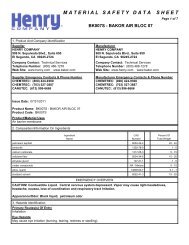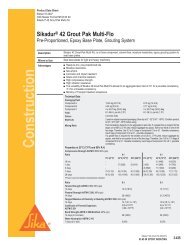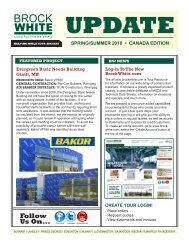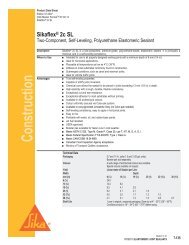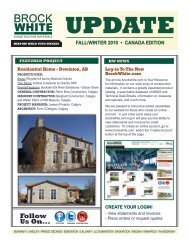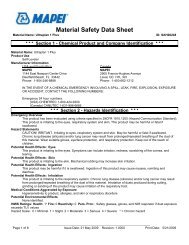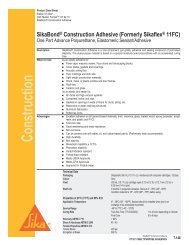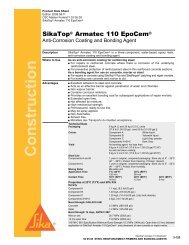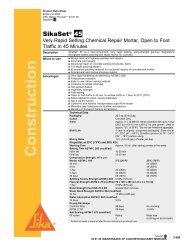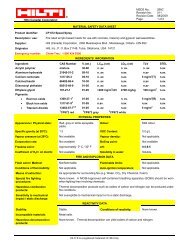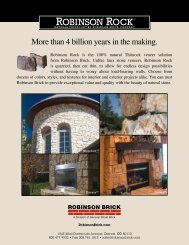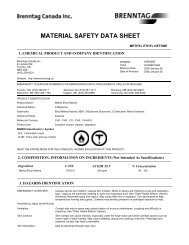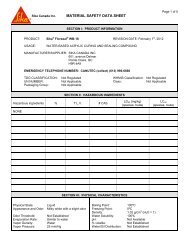Target Type 30 Cement MSDS - Brock White
Target Type 30 Cement MSDS - Brock White
Target Type 30 Cement MSDS - Brock White
Create successful ePaper yourself
Turn your PDF publications into a flip-book with our unique Google optimized e-Paper software.
<strong>Target</strong> <strong>Cement</strong> <strong>Type</strong> HE<br />
MATERIAL SAFETY DATA SHEET<br />
This Material Safety Data Sheet meets or exceeds the requirements of the Canadian<br />
Controlled Product Regulations (WHMIS)<br />
1. Product and Supplier Identification<br />
Product:<br />
<strong>Target</strong> <strong>Cement</strong> <strong>Type</strong> HE<br />
Product Use: <strong>Cement</strong> is used as a binder in concrete and mortars that are widely used in<br />
construction.<br />
Manufacturer: <strong>Target</strong> Products Ltd,<br />
1080 Bradner Road<br />
Abbotsford, BC<br />
V4X 1H8<br />
Telephone: 1.604.856.7976<br />
24-Hour Emergency Response Telephone for Transport Emergencies ONLY: +1 (613) 996-6666<br />
2. Composition<br />
Component % w/w Exposure Limits/ACGIH 1 LD 50 LC 50<br />
Calcium sulphate<br />
CAS No 13397-24-5<br />
Calcium Oxide<br />
CAS No 1<strong>30</strong>5-78-8<br />
Calcium Carbonate<br />
CAS 1317-65-3<br />
Magnesium Oxide<br />
CAS No 1<strong>30</strong>9-48-4<br />
Crystalline Silica<br />
CAS 14808-60-7<br />
Portland <strong>Cement</strong><br />
CAS No 65977-15-1<br />
1<br />
2-10 TLV-TWA: 10 mg/m 3 , irritation N. available N. available<br />
0-5 TLV-TWA: 2 mg/m 3 , irritation <strong>30</strong>59 mg/kg<br />
(dermal/<br />
mouse)<br />
0-5 TLV-TWA: 10 mg/m 3 , irritation 6450 mg/kg<br />
(rat/oral)<br />
N.available<br />
N. Available<br />
0-4 TLV-TWA: 10 mg/m 3 , inhalable fraction N.available N.available<br />
0-0.2 TLV-TWA: 0.05 mg/m 3 for respirable<br />
crystalline silica dust<br />
>31600<br />
mg/kg<br />
(rat/oral)<br />
>2<br />
mg/L<br />
(rat/1 hour)<br />
75-98 TLV-TWA: 10 mg/m 3 , irritation N.available N.available<br />
American Conference of Governmental Industrial Hygienists (ACGIH). Exposure limits may vary from time to<br />
time and from one jurisdiction to another. Check with local regulatory agency for the exposure limits in your<br />
area.<br />
3. Hazards Identification<br />
Routes of Entry:<br />
Skin Absorption: No<br />
Skin Contact: Yes<br />
Eye Contact:<br />
Yes<br />
Ingestion:<br />
Yes<br />
Inhalation:<br />
Yes<br />
Emergency Overview:<br />
<strong>Cement</strong> is a solid, grey, off-white odourless powder. It is not combustible or explosive. A single,<br />
short term exposure to the dry powder presents little or no hazard. Exposure of sufficient duration<br />
to wet cement or to dry cement on moist skin can cause serious, potentially irreversible e damage<br />
due to chemical burns, including third degree burns.<br />
. - 1 - November 29, 2007
<strong>Target</strong> <strong>Cement</strong> <strong>Type</strong> HE<br />
Calcium oxide is corrosive to eyes and skin and although these products contain small amounts<br />
of this chemical, care should be taken to limit skin exposure and prevent eye contact. Dust<br />
created from mishandling this product will cause irritation of the upper respiratory tract if inhaled.<br />
Sand (silicon dioxide) may contain crystalline quartz, which has been classified as a carcinogen<br />
by The International Agency for Research on Cancer (IARC). It has been concluded that<br />
crystalline silica in the form of quartz or cristobalite from occupational sources should be<br />
classified as carcinogenic to humans (Group 1). The major route of entry is inhalation, but the<br />
sand in this product is such that dusting of the silica is minimal.<br />
Acute Health Effects:<br />
Inhalation:<br />
Inhalation of cement dust will cause irritation to the upper respiratory tract. The dust that is<br />
created from improper handling procedures is mainly calcium oxide which can cause a minor<br />
burning sensation to the nostrils and mouth. Exposure may cause sore throat, coughing,<br />
sneezing, and the production of phlegm in the throat. Nosebleeds may occur in cases of those<br />
with sensitive nose membranes.<br />
Skin Contact:<br />
Exposure of sufficient duration to wet cement, or to dry cement on moist skin can cause serious,<br />
potentially irreversible damage to skin, eyes, respiratory and digestive tracts due to chemical<br />
(caustic) burns. Third degree burns are possible. Burns may be delayed. <strong>Cement</strong> mixtures can be<br />
very abrasive to skin, and may aggravate tender skin causing rash, cuts or sores.<br />
Skin Absorption:<br />
There is no evidence of any component of these products entering the body by this method.<br />
Eye Contact:<br />
Airborne dust may cause immediate or delayed irritation or inflammation. Eye contact with large<br />
amounts of dry powder or wet cement can cause injury ranging from moderate eye irritation to<br />
chemicals burns and blindness.Eye exposures require immediate first aid and medical attention<br />
to prevent significant damage to the eye.<br />
Ingestion:<br />
Oral toxicity is low, but ingestions may cause irritation of the gastrointestinal tract. Ingestion of<br />
large quantities of cement will cause chemical burns to the mouth, throat and upper respiratory<br />
tract as well as stomach cramps, vomiting, and diarrhea.<br />
Chronic Health Effects:<br />
The product contains crystalline silica. Prolonged or repeated inhalation of respirable crystalline<br />
silica from this product can cause silicosis, a serious disabling and fatal lung disease. Prolonged<br />
exposure to cement mixtures may produce dermatitis, thickening of the skin and eczema. This<br />
product is not expected to accumulate in the body. Presence of silicosis has been shown to<br />
increase the risk of tuberculosis.<br />
Medical Conditions Aggravated by Exposure:<br />
Respiratory problems may be aggravated by pre-existing lung disease such as bronchitis,<br />
emphysema, or chronic obstructive pulmonary disease. Sensitivity to hexavalent chromium may<br />
be aggravated by exposure to cement.<br />
. - 2 - November 29, 2007
<strong>Target</strong> <strong>Cement</strong> <strong>Type</strong> HE<br />
4. First Aid Measures<br />
Inhalation:<br />
If irritation causes coughing or phlegm, remove to fresh air. Call for medical assistance if<br />
coughing doesn’t subside.<br />
Skin Contact:<br />
Wash affected area thoroughly with a pH neutral soap or mild detergent and water. If irritation<br />
occurs or persists, seek medical attention.<br />
Eye Contact:<br />
Immediately and thoroughly flush eyes with large amounts of water for at least 15 minutes,<br />
occasionally lifting the lower and upper eyelids. If irritation, pain, swelling, or lacrimation exists,<br />
get medical attention as soon as possible.<br />
Ingestion:<br />
If patient is conscious, give one or two glasses of water. Do not induce vomiting. Do not give<br />
anything by mouth to a convulsing or unconscious person. Get immediate medical attention.<br />
General Comments:<br />
Good personal hygiene is essential. Avoid eating, smoking or drinking in work areas.<br />
Flammability: No<br />
5. Fire Fighting Measures<br />
Flash Point:<br />
Not applicable<br />
Autoignition Temperature:<br />
Lower Explosive Limit:<br />
Not applicable<br />
Not applicable<br />
Upper Explosive Limit:<br />
Not applicable<br />
Explosion Data:<br />
Sensitivity to Impact:<br />
No<br />
Sensitivity to Static Discharge: No<br />
Hazardous Combustion Products: None known<br />
Conditions to Avoid: None<br />
Extinguishing Media: These materials are not flammable. Use any medium necessary to<br />
extinguish surrounding fire. If possible, try to keep uninvolved product dry.<br />
Fire Fighting Instructions: Evacuate area and fight fire from a safe distance or a protected area.<br />
Approach fire from upwind. At high temperatures fumes of calcium oxide may evolve. Firefighters<br />
must wear self-contained breathing apparatus and full protective clothing to protect them from<br />
combustion products.<br />
. - 3 - November 29, 2007
<strong>Target</strong> <strong>Cement</strong> <strong>Type</strong> HE<br />
6. Accidental Release Measures<br />
Personal Protection:<br />
Wear adequate personal protection to prevent inhalation of dusts, contact with skin or eyes. See<br />
Section 8 for specific recommendations.<br />
Environmental Precautions:<br />
Prevent from spilling into waterways, sewers.<br />
Cleanup Procedures:<br />
Restrict access to area until completion of cleanup. Avoid harmful exposure to dusts or wet<br />
cement. Only adequately trained personnel, wearing properly selected personal protective<br />
equipment and clothing described in Section 8, should be involved in the spill response and<br />
cleanup. Place spilled material into an appropriate container. Scrape wet cement and place in<br />
container. Allow wet material to dry and harden before disposing.<br />
7. Handling and Storage<br />
Handling Procedures:<br />
This material is mildly corrosive and reactive with water. Handle bags in a manner that will ensure<br />
minimal generation of dusts. Do not get on skin or do not breathe dust, which may generate<br />
accidentally. Follow safe work procedures and wear the appropriate personal protective<br />
equipment specified in Section 8. The workers must be instructed and trained in the safe work<br />
procedures.<br />
To prevent accidental burial or suffocation, do not enter confined spaces such as storage silos,<br />
bin, bulk truck, or other storage vessels that contains cement. <strong>Cement</strong> can adhere to walls of a<br />
confined space and them release, fall or collapse unexpectedly.<br />
Due to potential static build up on conveyors or other cement handling devices, ground<br />
equipment to prevent damage to electrical components and injury to workers.<br />
Storage:<br />
Keep dry! This product reacts with water to harden. Store in a sheltered area away from moisture.<br />
Do not store near foodstuffs. Store away from incompatible materials such as strong acids. Bags<br />
must be stacked in a safe manner to prevent falling.<br />
8. Exposure Controls, Personal Protection<br />
Engineering Controls:<br />
Ensure that sufficient ventilation is available to keep dust below the TLV. If possible, mix this<br />
product outdoors. Airborne concentrations should be low, however, provide adequate ventilation<br />
to ensure airborne concentrations are kept below applicable regulated exposure limits.<br />
Respiratory Protection:<br />
Respirators must be NIOSH approved and properly selected, maintained and used when working<br />
with this product. Knowledge of respiratory hazards and respiratory protection is essential to<br />
ensure appropriate selection of respirators. Use an approved NIOSH dust respirator with a<br />
minimum N95 rating.<br />
Skin Protection:<br />
Wear clothing to prevent contact with skin.<br />
. - 4 - November 29, 2007
<strong>Target</strong> <strong>Cement</strong> <strong>Type</strong> HE<br />
Eye and Face Protection:<br />
Wear safety glasses to prevent contact with eyes and make immediately available appropriate<br />
emergency eyewashing equipment (e.g. portable or plumbed) capable of flushing the eyes for at<br />
least 15 minutes.<br />
9. Physical and Chemical Properties<br />
Physical State: Solid powder Solubility in water: Slightly soluble (0.1 to<br />
1.0%)<br />
Appearance: Gray, off-white or white Melting Point: Not applicable<br />
Odour: None Boiling Point: > 1000 o C<br />
Odour Threshold: Not applicable Specific Gravity 3.15<br />
(Water=1):<br />
pH (supernatant): 12-13 Coefficient of Not applicable<br />
water/oil<br />
Distribution:<br />
Vapour Pressure: Not applicable Evaporation Rate Not applicable<br />
Vapour Density<br />
(Air=1):<br />
Not applicable<br />
(Butyl Acetate=1):<br />
10. Stability and Reactivity<br />
Chemical Stability:<br />
Hazardous Polymerization:<br />
Incompatibility:<br />
Reactivity:<br />
This product is stable. Keep dry until use.<br />
Will not occur.<br />
Wet cement is alkaline and is incompatible with acids,<br />
ammonium salts and aluminum metal. <strong>Cement</strong> dissolves<br />
in hydrofluoric acid, producing corrosive silicon<br />
tetrafluoride gas. <strong>Cement</strong> reacts with water to form<br />
silicates and calcium hydroxide. Silicates react with<br />
powerful oxidizers such as fluorine, boron trifluoride,<br />
chlorine trifluoride, manganese fluoride, and oxygen<br />
difluoride.<br />
Yes. Reacts with water forming polymerized silicates<br />
and calcium oxide.<br />
Hazardous Decomposition Products: None<br />
11. Toxicological Information<br />
Effects of Acute Exposure: See Section 3<br />
Effects of Chronic Exposure: See Section 3<br />
Irritancy: Yes. See Section 3.<br />
Skin Sensitization:<br />
None reported<br />
Respiratory Sensitization: None reported<br />
Neurotoxicity:<br />
No<br />
Carcinogenicity:<br />
Crystalline silica is listed by IARC<br />
Embryotoxicity:<br />
No<br />
Teratogenicity:<br />
No<br />
Reproductive Toxicity: No<br />
Mutagenicity:<br />
No<br />
Synergistic Products:<br />
None reported<br />
. - 5 - November 29, 2007
<strong>Target</strong> <strong>Cement</strong> <strong>Type</strong> HE<br />
12. Ecological Information<br />
Environmental Toxicity: Hardened concrete has no environmental toxicity. Do not pour<br />
powdered product into the environment, waterways or sewers<br />
Biodegradability: Hardened concrete will not biodegrade.<br />
13. Disposal Considerations<br />
Review federal, provincial or state, and local government requirements prior to disposal. Store<br />
material for disposal as indicated in Storage Conditions. Disposal by controlled incineration may<br />
be acceptable.<br />
14. Transport Information<br />
Canadian Transportation of Dangerous Goods Regulations: Not regulated<br />
International Air Transport Association (IATA):<br />
International Maritime Organization (IMO):<br />
Not regulated<br />
Not regulated<br />
15. Regulatory Information<br />
CANADIAN FEDERAL REGULATIONS:<br />
CEPA, DOMESTIC SUBSTANCES LIST: Listed<br />
WHMIS CLASSIFICATION:<br />
E, D2A<br />
Original Preparation Date: November 29, 2007<br />
16. Other Information<br />
Prepared by: Kel-Ex Agencies Ltd., P.O. Box 52201, Lynnmour RPO, North Vancouver, BC,<br />
Canada, V7J 3V5<br />
Disclaimer: This Material Safety Data Sheet was prepared in accordance with criteria and<br />
requirements of the Hazardous Products Act and the Controlled Products Regulations using<br />
information provided by the manufacturer and other sources including CCINFO (Chemical<br />
Information published by the Canadian Centre for Occupational Health and Safety). The<br />
information in the Material Safety Data Sheet is offered for your consideration and guidance when<br />
exposed to this product. TARGET PRODUCTS LTD. expressly disclaims all expressed or implied<br />
warranties and assumes no responsibilities for the accuracy or completeness of the data<br />
contained herein. The data in this <strong>MSDS</strong> does not apply to use with any other product or in any<br />
other process.<br />
This Material Safety Data Sheet may not be changed, or altered in any way without the<br />
expressed knowledge and permission of TARGET PRODUCTS, LTD.<br />
Revisions: None<br />
. - 6 - November 29, 2007



